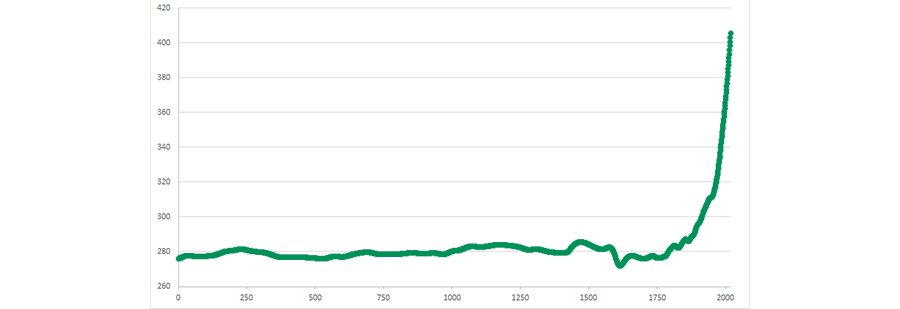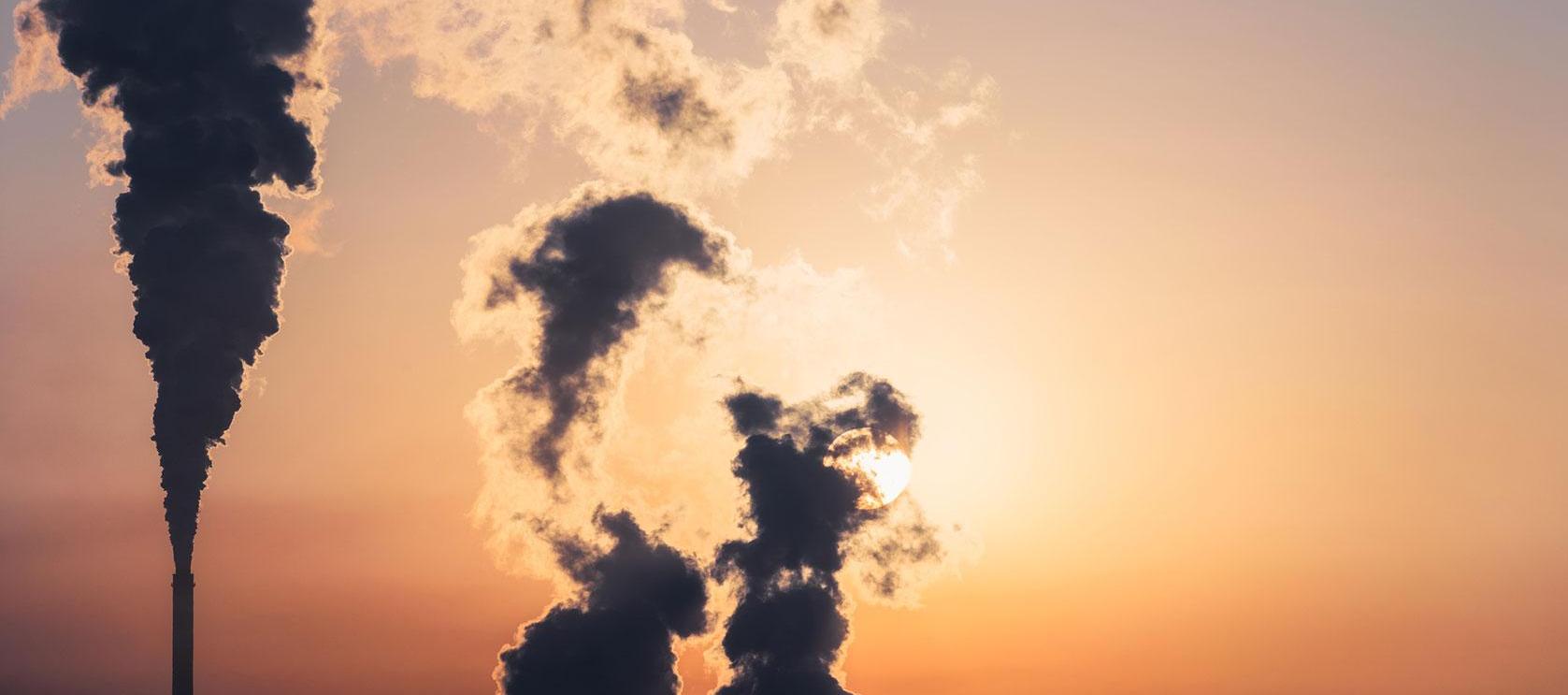On the 10 warmest
years in the 139-year record, all were all after 2005; the five warmest were
the five most recent. In 2018, overall losses from weather-related disasters
totalled $225 billion.
Climate modelling is
complicated – but the evidence is increasingly strong: with ever-greater greenhouse
gas (GHG) emissions, these models predict a significant warming effect,
increasing the likelihood of the destruction of ecosystems and a greater
frequency of extreme weather events. This has the potential to incur enormous social
and economic costs.

Carbon dioxide (CO₂) is the most abundant greenhouse gas – excluding water vapour – and its concentration has been increasing well beyond the maximum historical level since 1950. An increase in CO₂ concentration induces a rise in global temperature – global warming – through the ‘greenhouse’ effect. Decarbonisation is crucial to slow down climate change and reduce its cost for society. However, as our production and economic models cannot be changed instantly, decarbonisation can be accompanied by the offsetting of residual GHG emissions.

Carbon action: measure, reduce, offset

Companies – and individuals – can generally
start to reduce CO₂ emissions straight away, but they need to measure their carbon
footprint in order to see how they are progressing. The sources of emissions can vary
depending on the type of company:
- Scope 1 emissions are direct greenhouse gas emissions that come from sources owned or controlled by a company. For example, the on-site production of electricity, heat or steam; physical and chemical processes; transportation of goods and people.
- Scope 2 emissions are indirect greenhouse gas emissions that come from purchased electricity or steam consumed by a company.
- Scope 3 emissions are indirect emissions in the value chain of the reporting company, including both upstream and downstream emissions. Examples include business travel, employee commutes, production of purchased materials, investments, leased assets and franchises, and waste disposal.
| The Kyoto Protocol to the United Nations Framework Convention on Climate Change (UNFCCC),
signed in December 1997, established a system imposing national caps on the
greenhouse gas emissions of developed countries that ratified the agreement.
These countries were given legally binding emission reduction obligations, and
any emissions permitted but not used could be sold – effectively creating a new
commodity and marking the beginning of what is known as “carbon trading“.
Its first commitment period was in 2008-12, and the second started in 2013 and
will end in 2020.
|
Once its carbon footprint has been measured, a company can set up a reduction strategy. Below are a few ways to reduce emissions, either at a business or an individual level.
But even with the most determined efforts to reduce CO₂ emissions, it is impossible to reach carbon neutrality in this way alone. A reduction strategy can therefore be accompanied by carbon offsetting, which is based on the principle that a given tonne of CO₂ emitted in one place can be compensated through carbon avoidance or capture somewhere else.
There are two kinds of carbon markets, compliance carbon markets and voluntary ones. The former are for companies and governments which by law have to account for their GHG emissions, and are regulated by national, regional or international authorities. The first and biggest example is the EU Emissions Trading System (EU ETS). The voluntary markets are for players that are not subject to regulatory constraints, or that are subject to constraints but wish to go beyond their regulatory obligations.
| Market | Regulatory framework | Period of application | Scope | Principle | Carbon product |
| Regulated |
Kyoto Protocol & Paris Agreement |
2005 – 2020 & 2020 – 2030 |
International | – Emissions quota trading system for industralised countries within the framework of the CDM – Free trading of certified emission reduction units (CER) for participants |
CER |
| European | – European equivalent of the international regulated carbon market – 31 participating member countries – Capping of emissions from the 11.000 most polluting manufacturing and power plants |
EUA CER |
|||
| Voluntary | None | Since 2005 | International | – Carbon offset trading system on a voluntary basis for companies, local authorities and private individuals wishing to co-finance emission reduction projects – No objectives for reduction or capping |
VER |
Sustainable projects for carbon offsetting
In the voluntary markets, the carbon credit buyer acquires a number of Verified Emission Reduction (VERs) or carbon offsets corresponding to the volume of GHG emissions that it wishes to offset. The amount paid for this purpose – which can vary – contributes directly or indirectly to the funding of a specific carbon emissions reduction project.Project developers working with the voluntary markets can produce offsets from a variety of activities, from the installation of renewable energy infrastructure like wind turbines or solar panels to planting trees that remove and store carbon from the atmosphere.
| Project categories | Projects with issued offsets | Volume of offsets issued in MtCO2e (2005 – present) | New projects |
|
Agriculture – modifying agricultural practices to reduce emissions by switching to no-till farming, reducing chemical fertilizer use, etc |
87 | 6.7 | 1 |
|
Chemical Processes and Industrial Manufacturing – modifying industrial processes to emit fewer greenhouse gases |
72 | 63.5 | 0 |
|
Energy Efficiency and Fuel Switching – improving energy efficiency or switching to cleaner fuel sources |
633 | 127.9 | 8 |
|
Forestry and Land Use – managing forests, soil, grasslands, and other land types to avoid releasing carbon and/or increasing the amount of carbon the land absorbs |
170 | 95.3 | 3 |
|
Household Devices – distributing cleaner-burning stoves or water purification devices to reduce or eliminate the need to burn wood (or other inefficient types of energy). |
161 | 23.4 | 0 |
|
Renewable Energy – installing solar, wind, and other forms of renewable energy production |
611 | 61.9 | 2 |
|
Transportation – increasing access to public and/or alternative transportation (like bicycling) and reducing emissions from private transportation like cars and trucks |
43 | 1.1 | 0 |
|
Waste Disposal – reducing methane emissions from landfills or wastewater, often by collecting converting it to usable fuel |
238 | 57.5 | 0 |
Locations for projects include developing countries, emerging economies and developed countries. Projects carried out in developing countries usually include both environmental and social components, in line with the United Nations Sustainable Development Goals (UN SDGs).
BNP Paribas solutions for carbon offsetting
To help clients become carbon neutral, in collaboration with Nobel Peace Prize Laureate Professor Yunus BNP Paribas has launched ClimateSeed, a Social Business. ClimateSeed reinvests 100% of its profits to maximise its positive environmental impact. It offers a digital platform that corporations and organisations can use to offset their residual CO2 emissions. They can support a variety of high-quality sustainable projects including the fight against deforestation, energy efficiency, renewables, household devices, water and waste management through the purchase of carbon credits (VERs) in more than 20 countries. All the projects are internationally certified and analysed via a strict due diligence process. These projects not only avoid or capture CO₂ but also contribute to the achievement of the UN Sustainable Development Goals.BNP Paribas’ Global Markets also offers carbon offsetting services. Global Markets has been involved in providing finance to projects reducing emissions and generating carbon offsets for more than 10 years. It can source VERs from high-quality projects delivering emission reductions as well as social and environmental co-benefits which are verified by rigorous standards. Besides offering project sourcing and structuring spot and forward transactions to hedge future client requirements, Global Markets has also been developing an array of sustainable investment solutions, such as the European climate carbon offset plan.
What’s next?
In terms of sustainable technology, carbon capture, utilisation and storage (CCUS) technology is advancing to become more affordable and scalable. The aim is to capture CO₂ from the air – directly or from flue-gas emissions – and store it where it will not enter the atmosphere, generally in an underground geological formation. Depleted oil and gas reservoirs are considered to be among the most practical options for storage. Some technologies can even transform the captured CO₂ into fuel, promoting a circular economy.On the subject of offsetting specifically, the launch of initiatives in areas such as fashion (the G7 Fashion Pact) and aviation (CORSIA) will at very least increase the visibility of the carbon market. In addition, as people are becoming more aware of the impact of climate change, customers are putting pressure on corporations to adopt a comprehensive sustainable strategy that includes emissions reduction and even the offsetting of unavoidable emissions.
 |
Change your diet ● Limit meat consumption, add other sources of vegetable proteins to your diet |
 |
Change
your relationship to technology and the internet ● Turn off devices when not in use – technological equipment produces 608 tonnes of GHG per year ● Limit emails with attachments – each consumes as much energy as a light bulb lit for 24 hours ● Swap your desktop computer for a laptop, which consumes 80% less energy. |
 |
Change your consumption habits ● Favour second-hand and local products ● Choose products that last longer ● Join the circular economy by giving away or selling products you no longer use ● Offset emissions linked to your purchases |
 |
Change
your transport habits ● Limit air travel ● Cycle or walk to work, or ● Use public transport |
 |
Switch to LED lighting ● LED bulbs use 15 times less electricity than halogen lighting |
 |
Recycle waste ● Metal, glass, plastic, paper… |
 |
Use energy-efficient appliances, and use them efficiently ● Make sure every appliance is energy-efficient ● Enable power-saver mode |
 |
Reduce
business-related travel ● Allow remote working, which saves emissions from commuting ● Promote video conferences, limiting work trips to what is strictly necessary |
Content provided by ClimateSeed, BNP Paribas’ B-to-B digital carbon offsetting platform
Read more: Energy transition: a matter of finance
